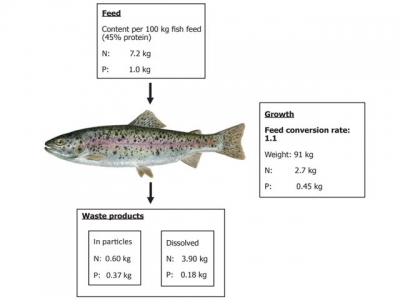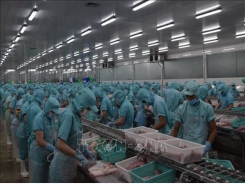A Guide to Recirculation Aquaculture - Part 10

Chapter 6: Waste water treatment
Figure 6.1 Excretion of nitrogen (N) and phosphorus (P) from farmed fish. Note the amount of N excreted as dissolved matter. Source: Biomar and the Environmental Protection Agency, Denmark.
Farming fish in a recirculation system where the water is constantly reused does not make the waste from the fish production disappear. Dirt or excretions from the fish still have to end somewhere.
The biological processes within the RAS will in a smaller scale reduce the amount of organic compounds, because of simple biological degradation or mineralisation within the system. However, a significant load of organic sludge from the RAS will still have to be dealt with.

Figure 6.2 Sketch of flows to and from a recirculation aquaculture system.
Most RAS will have an overflow of process water for balancing the water going in and out of the system. This water is the same water as the fish are swimming in, and is as such not a pollutant unless the discharged amount of water from the overflow is excessive and the yearly discharge through this point escalates. The more intensive the rate of recirculation, the less water will be discharged through the overflow.
The waste water leaving the recirculation process typically comes from the mechanical filter, where faeces and other organic matters are separated into the sludge outlet of the filter. Cleaning and flushing biofilters also adds to the total waste water volume from the recirculation cycle.
Treating the waste water leaving the RAS can be accomplished in different ways. Quite often a buffer tank is installed prior to the sludge treatment system where sludge is separated from the discharge water. Sludge will go to an accumulation facility for sedimentation or further mechanical dewatering, before it is spread on land, typically as fertilizer and soil improvement on agricultural farms, or it can be used in biogas production for generating heat or electricity. Mechanical dewatering also makes the sludge easier to handle and minimises the volume whereby disposal or possible fees becomes cheaper.

Figure 6.3 The pathways of sludge and water inside and outside a recirculation system. The higher the rate of recirculation, the lower the amount of water let out from the system (dotted line), and the lower the amount of waste water to be treated. Source: Hydrotech.

Figure 6.4 Hydrotech belt filter used as secondary water treatment for dewatering the sludge.

Figure 6.5 A plant lagoon placed after a recirculation trout farm in Denmark - before and after overgrowing. Source: Per Bovbjerg, DTU Aqua.
The cleaned waste water from the sludge treatment will usually have a high concentration of nitrogen, whereas the phosphorus can be almost removed completely in the sludge treatment process. This discharge water is called reject water, and is most often discharged to the surroundings, river, sea, etc. together with the overflow water from the RAS. The content of nutrients in the reject water and in the overflow water can be removed by directing it to a plant lagoon, root zone or seepage system, where remaining phosphorous and nitrogenous compounds can be further reduced.
As an alternative, the reject water can be used as fertilizer in aquaponics systems. Aquaponics are systems where the waste from the fish is used for growing vegetables, plants or herbs, typically inside greenhouses. For larger fish farming systems it is recommended that the sludge is used for agricultural land and biogas, whereas the reject water is used for the aquaponics as this is simpler to handle and adjust with regards to cultures in greenhouses.

Figure 6.6 The EcoFutura project explored the possibility of cultivating tomatoes with the growing of Nile tilapia (Oreochromis niloticus). Source: Priva (Netherlands)
The content of nitrogen in the discharge water can also be removed by denitrification. As described in chapter 2, methanol is most commonly used as the carbon source for this anaerobic process, which transforms nitrate to free nitrogen to the atmosphere thus removing the nitrate from the reject water. Denitrification can also be used inside the recirculation system to reduce the amount of nitrate in the RAS process water in order to reduce the nitrate concentration, thus minimizing the need for new water in the system. The use of denitrification outside the recirculation system is carried out in order to reduce the discharge of nitrogen into the environment. As an alternative to the use of methanol, the reject water coming from the sludge treatment system can be used as the carbon source. Using reject water as carbon source requires tight management of the denitrification chamber, and back-washing and cleaning the chamber can become more difficult. In any case, an efficient denitrification system can reduce the nitrogen content in the effluent water significantly.
It should be noted that fish excrete waste in a different way than other animals such as pigs or cows. Nitrogen is mainly excreted as urine via the gills, while a smaller part is excreted with faeces from the anus. Phosphorous is excreted with the faeces only. The main fraction of the nitrogen is therefore dissolved completely in the water and cannot be removed in the mechanical filter. The removal of faeces in the mechanical filter will catch a smaller part of the nitrogen fixed in the faeces, and to a larger extent the amount of phosphorous. The remaining dissolved nitrogen in the water will be converted in the biofilter mainly to nitrate. In this form nitrogen is readily taken up by plants and can be used as fertilizer in agriculture or simply be removed in plant lagoons or root zone systems.

Figure 6.7 Removal of nitrogen (N), phosphorus (P) and suspended solids (SS) from mechanical filter. Source: Fisheries Research Station of Baden-Württemberg, Germany.
Faeces from the fish tanks should flow immediately to the mechanical filter without being crushed on the way. The more intact and solid the faeces are, the higher the level of removed solids and other compounds. Figure 6.7 shows the estimated removal of nitrogen, phosphorous and suspended solids (organic matter) in a mechanical filter of 50 micron.
The higher the rate of recirculation the less new water will be used, and the less discharge water will need to be treated. In some cases, no water at all will return to the surrounding environment. However, this kind of “zero discharge” fish farming is costly to build and the running costs for the waste treatment are significant. Also, daily operation of the waste treatment will require significant attention to make it work efficiently. For zero-discharge fish farming one should also be aware that a certain amount of water exchange is always needed to prevent the accumulation of metals and phosphorous compounds in the system. The bottom line is that authorities and the fish farmer must agree on a discharge permission that allows protecting the environment whilst having an economical viable fish farming business.
Combining intensive fish farming, whether recirculation or traditional, with extensive aquaculture systems, such as for example traditional carp culture, can be an easy way to handle biological waste. The nutrients from the intensive system are used as fertilizer in the extensive ponds when the excess water from the intensive farm flows to the carp pond area. Water from the extensive pond area can be reused as process water in the intensive farm. Growth of algae and water plants in the extensive ponds will be eaten by the herbivorous carp, which in the end are harvested and used for consumption. Efficient rearing conditions are obtained in the intensive system and the environmental impact has been accounted for in combination with the extensive pond area.

Figure 6.9 Combined intensive-extensive fish farming systems in Hungary. The number of opportunities seems unlimited. Source: Laszlo Varadi, Research Institute for Fisheries, Aquaculture and Irrigation (HAKI), Szarvas, Hungary.
Related news
Tools

Phối trộn thức ăn chăn nuôi

Pha dung dịch thủy canh

Định mức cho tôm ăn

Phối trộn phân bón NPK

Xác định tỷ lệ tôm sống

Chuyển đổi đơn vị phân bón

Xác định công suất sục khí

Chuyển đổi đơn vị tôm

Tính diện tích nhà kính

Tính thể tích ao




 Mekong Delta catfish farmers worry about lower prices
Mekong Delta catfish farmers worry about lower prices  Shrimp exporters look forward to H2 comeback
Shrimp exporters look forward to H2 comeback